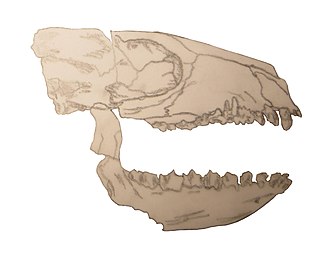
Litopterna is an extinct order of fossil hoofed mammals from the Cenozoic era. The order is one of the five great orders of South American ungulates that were endemic to the continent, until the Great American Biotic Interchange brought new ungulate species. Like other endemic South American mammals, their relationship to other mammal groups had long been unclear, but recent genetic and proteomic evidence indicates that their closest living relatives are Perissodactyls including horses, rhinoceros, and tapirs, and that litopterns are closely related to notoungulates, another widespread group of South American ungulates.

Cramauchenia is an extinct genus of litoptern South American ungulate. Cramauchenia was named by Florentino Ameghino. The name has no literal translation. Instead, it is an anagram of the name of a related genus Macrauchenia. This genus was initially discovered in the Sarmiento Formation in the Chubut Province, in Argentina, and later it was found in the Chichinales Formation in the Río Negro Province and the Cerro Bandera Formation in Neuquén, also in Argentina, in sediments assigned to the SALMA Colhuehuapian. In 1981 Soria made C. insolita a junior synonym of C. normalis. A specimen of C. normalis was described in 2010 from Cabeza Blanca in the Sarmiento Formation, in sediments assigned to the Deseadan SALMA.
The Tiupampan age is a period of geologic time within the Paleocene epoch of the Paleogene used more specifically with South American land mammal ages (SALMA). It is the oldest SALMA age and precedes the Peligran age.
The Peligran age is a period of geologic time within the Paleocene epoch of the Paleogene, used more specifically with South American land mammal ages (SALMA). It follows the Tiupampan and precedes the Riochican age.

Proborhyaenidae is an extinct family of metatherian mammals of the order Sparassodonta, which lived in South America from the Eocene (Mustersan) until the Oligocene (Deseadan). Sometimes it has been included as a subfamily of their relatives, the borhyaenids. The largest species, Proborhyaena gigantea, is estimated to be about the size of a spectacled bear, with its skull reaching 60 cm (2.0 ft) in length, and body mass estimates up to approximately 150–200 kilograms (330–440 lb), making the proborhyaenids some of the largest known metatherians. Proborhyaenid remains have been found in western Bolivia, Uruguay, southern Brazil, and the provinces of Mendoza, Salta, and Chubut, in Argentina.

The Golfo San Jorge Basin is a hydrocarbon-rich sedimentary basin located in eastern Patagonia, Argentina. The basin covers the entire San Jorge Gulf and an inland area west of it, having one half located in Santa Cruz Province and the other in Chubut Province. The northern boundary of the basin is the North Patagonian Massif while the Deseado Massif forms the southern boundary of the basin. The basin has largely developed under condition of extensional tectonics, including rifting.
Ernestokokenia is an extinct genus of mammal, belonging to the Didolodontidae. It lived during the Early Eocene and the Middle Eocene, and its fossils were discovered in South America.
Lamegoia is an extinct genus of mammals, belonging to the family Didolodontidae. It contains a single species, Lamegoia conodonta, which lived during the Late Paleocene in what is now South America.
Paulogervaisia is an extinct genus of mammal, belonging to the family Didolodontidae. Its fossilized remains have been found in South America.
Notoetayoa is an extinct genus of mammal, from the order Xenungulata. It contains a single species, Notoetayoa gargantuai, which lived during the Middle Paleocene. Its fossilized remains were discovered in South America.
Protolipterna is an extinct genus of mammal, belonging to the order Litopterna. It lived during the Late Paleocene and the Early Eocene, in what is now South America.
Proadiantus is an extinct genus of herbivorous mammal, belonging to the order Litopterna. It lived during the Late Oligocene, in what is today South America.

Adiantoides is an extinct genus of herbivorous mammal, belonging to the order Litopterna. It lived during the Middle to Late Eocene, in South America.
Notonychops is an extinct genus of mammal, belonging to the order Litopterna, that lived during the Middle to Late Paleocene in what is today South America.

Anisolambda is an extinct genus of litoptern. It lived from the Late Paleocene to the Middle Eocene in what is now Argentina.
Wainka is an extinct genus of South American mammal, belonging to the order Litopterna. It lived during the Middle Paleocene.
Proectocion is an extinct genus of herbivorous mammal, belonging to the order Litopterna. It lived during the Early Eocene, in what is now South America.

Protheosodon is an extinct genus of proterotheriid litoptern. It lived from the Late Oligocene to the Early Miocene in what is now Argentina and Colombia.
Henricosbornia is an extinct genus of henricosborniid notoungulate that lived from the Late Paleocene to the Middle Eocene of what is now Argentina and Brazil.

The Salamanca Formation is a geologic formation in the Golfo San Jorge Basin of southern Argentina that yields well-preserved, well-dated fossils from the early Paleocene. Studies of these fossils are providing new data on plant and animal diversity following the end-Cretaceous extinction event.















